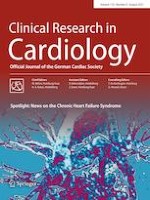Published in:

01-08-2021 | Heart Failure | Original Paper
Predicting survival in heart failure: a risk score based on machine-learning and change point algorithm
Authors:
Wonse Kim, Jin Joo Park, Hae-Young Lee, Kye Hun Kim, Byung-Su Yoo, Seok-Min Kang, Sang Hong Baek, Eun-Seok Jeon, Jae-Joong Kim, Myeong-Chan Cho, Shung Chull Chae, Byung-Hee Oh, Woong Kook, Dong-Ju Choi
Published in:
Clinical Research in Cardiology
|
Issue 8/2021
Login to get access
Abstract
Objective
Machine learning (ML) algorithm can improve risk prediction because ML can select features and segment continuous variables effectively unbiased. We generated a risk score model for mortality with ML algorithms in East-Asian patients with heart failure (HF).
Methods
From the Korean Acute Heart Failure (KorAHF) registry, we used the data of 3683 patients with 27 continuous and 44 categorical variables. Grouped Lasso algorithm was used for the feature selection, and a novel continuous variable segmentation algorithm which is based on change-point analysis was developed for effectively segmenting the ranges of the continuous variables. Then, a risk score was assigned to each feature reflecting nonlinear relationship between features and survival times, and an integer score of maximum 100 was calculated for each patient.
Results
During 3-year follow-up time, 32.8% patients died. Using grouped Lasso, we identified 15 highly significant independent clinical features. The calculated risk score of each patient ranged between 1 and 71 points with a median of 36 (interquartile range: 27–45). The 3-year survival differed according to the quintiles of the risk score, being 80% and 17% in the 1st and 5th quintile, respectively. In addition, ML risk score had higher AUCs than MAGGIC-HF score to predict 1-year mortality (0.751 vs. 0.711, P < 0.001).
Conclusions
In East-Asian patients with HF, a novel risk score model based on ML and the new continuous variable segmentation algorithm performs better for mortality prediction than conventional prediction models.
Clinical Trial Registration